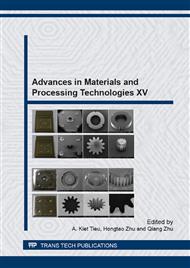p.144
p.153
p.160
p.166
p.176
p.186
p.195
p.203
p.211
Investigation and Comparison of Heat Transfers Analysis Used in Commercial FEM for Metal Forming
Abstract:
During an Aluminium extrusion process, the extrusion parameters, i.e. friction, heat transfer, etc. are significantly influence by the temperature gradients produced in the billet during transfer to the container and after upsetting the container. The heat transfer at the tool/billet interface governs the temperature profile throughout the billet and tools during extrusion and consequently has a critical influence on the results. Although FEM technique offers great potential, care must be taken when applying the analysis to the hot extrusion of rate sensitive alloys. The most useful approach of an FEM simulation would thus be to include both the tooling and the billet in the calculation as discretised meshes. Because of the occurrence of the conductive and convective heat transfer, the deformation during hot extrusion is not adiabatic and estimation of the temperature increase is alloy dependent. The aim of this paper is to investigate and to compare how commercial FEM codes assign and deal with the heat transfer parameter at the tool/material interface. Three commercial FEM codes were investigated and compared; Simufact, Deform and Forge. The usefulness and limitation when using commercial FEM codes are discussed. Methods to assess difficulty of comparison are presented. The work illustrates the essentials of numerical analysis in the comprehension of the thermo-mechanical events occurring during large deformation. Results are presented for velocity distribution and temperature evolution in both materials and tools. It is shown that the heat transfer parameter to be extremely sensitive when attempting to simulate the hot deformation. Moreover, the accuracy of the results does not only depended on the geometric definition of the tooling and material data but also the governing boundary conditions between the material and tooling.
Info:
Periodical:
Pages:
176-185
Citation:
Online since:
November 2013
Authors:
Keywords:
Price:
Сopyright:
© 2014 Trans Tech Publications Ltd. All Rights Reserved
Share:
Citation:


